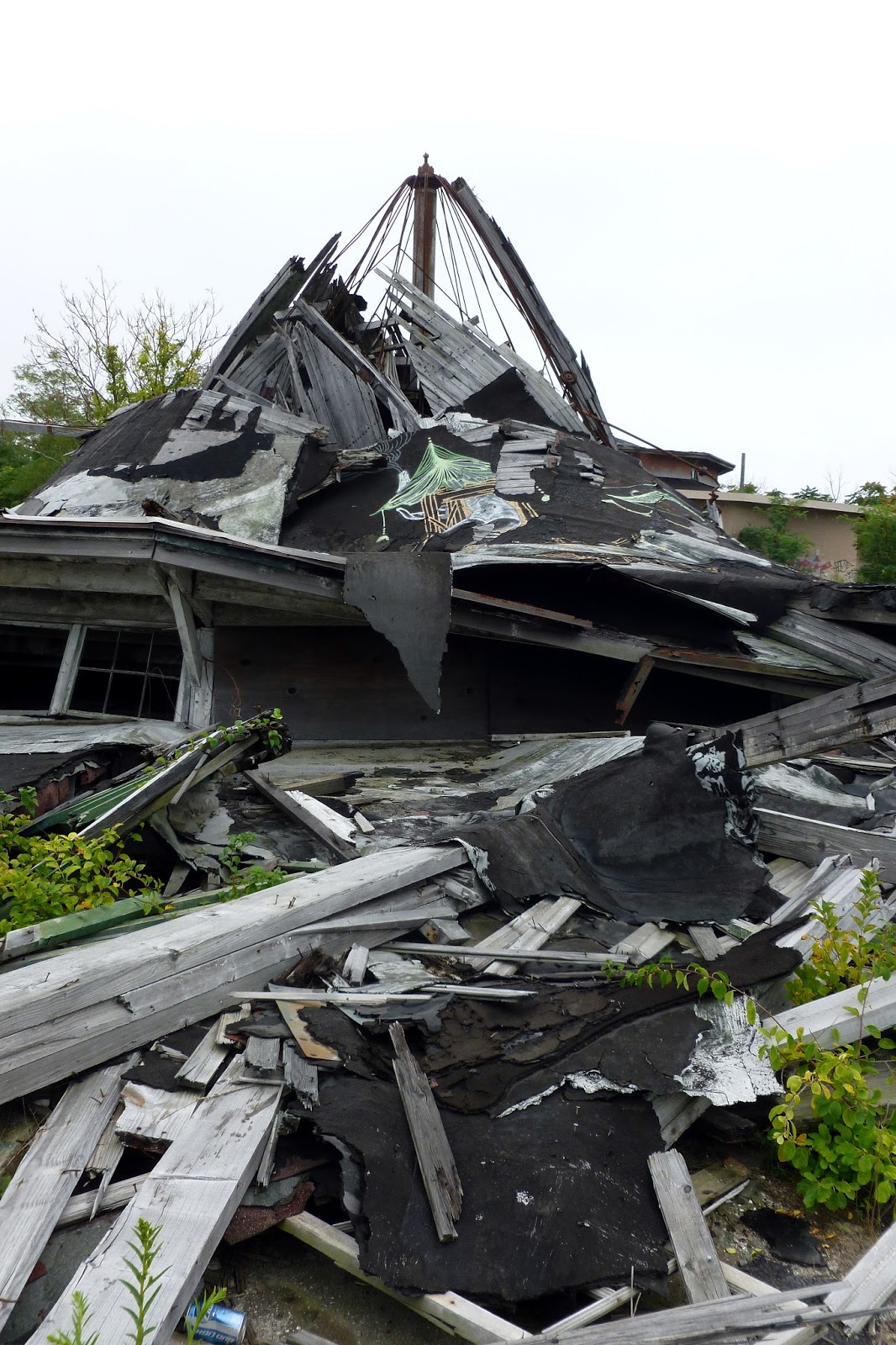 |
| Sunlight breaks through the clouds over Bridgeport as seen from the shoreline of Long Beach West in Stratford. |
 |
| This satellite image from Google Maps shows the thin thread of Long Beach West to the east and the thicker mass of Pleasure Beach to the West. |
The barrier beach peninsula
known variously as Long Beach West (on the Stratford-owned side) and Pleasure
Beach (on the Bridgeport-owned side) has changed drastically in the last few
years.
For over a decade after the
only bridge burned down in 1996, efforts to revitalize the former tourist
attraction stalled.
 |
| Rusted nails stick out of what is left of the burned-out bridge. |
But things are happening
there again.
In 2009, Stratford voters
approved a deal to let the U.S.
Fisheries and Wildlife Service take control of their half of the land to
restore it to its natural state. Gone are the iconic cottages that once brought
so much enjoyment to a few wealthy summer sojourners – and so much
consternation to firefighters when conflagrations engulfed some of the
abandoned hulks shortly after the vote. As part of the deal, the area was made
accessible to residents in perpetuity. This, ironically, has increased foot
traffic.
 |
| Few traces exist of the cottages that were purposefully removed from the beach. However, charred debris lines the beach in the areas where cottages burned to the ground. |
Bridgeport, meanwhile, has
been working on bringing people back to its half of the land. Mayor Bill
Finch said in March a pair of water taxis that could carry about 30 people were
on order. At the time, the city expected the service to be in full swing by the
2014 summer season.
To make that happen, Bridgeport
has begun rebuilding a pier at Pleasure Beach as well as cleaning up some of
the dilapidated buildings.
 |
| Inside the auditorium at Pleasure Beach. Some parts of the roof and walls have collapsed, and the interior is caked with mold. |
In the preceding years,
numerous plant and animal species had taken over. Rabbits, turtles, owls,
osprey, piping plover, prickly pear cactus, sea lavender – all these and more
lived relatively undisturbed lives in the ruins people had left behind. The
unchecked growth gave some areas an almost jungle-like feel.
Stratford and Bridgeport may
have different visions for the peninsula, but both involve wresting back
control of the landscape. And both are moving forward.
Already, a few of the animals
are conspicuously absent. The rabbits, which used to be so prolific that one
would spot dozens on a casual walk, are nowhere to be seen. The osprey had
built their nests atop telephone poles, which they would defend menacingly
against anyone who came too close. New poles were built specifically for the
birds, but some chose instead to build nests inside the WICC transmission
towers.
 |
| ...but the transmission towers are in use. |
A management
plan prepared for the Stratford Parks Department in January gave an
extensive listing of the plant species on the beach. Many are invasive, and
some were planted by the former cottage dwellers. The report recommends cutting
some of the plants down, pulling some up, and using herbicides on still others.
 |
| A stand of invasive tree of heaven (ailanthus altissima). |
 |
| A seaside goldenrod (Solidago sempervirens) in bloom. |
 |
| An evening primrose (Oenothera parviflora) stands tall amidst the surrounding invasive beach rose (Rosa rugosa). |
 |
| A seaside spurge ( Euphorbia polygonifolia) fans out from the sand. |
 |
| A patch of Eastern prickly pear (Opuntia humifusa), the only cactus native to Connecticut and a species of special concern. |
Bridgeport has brought in construction
materials. An owl that had lived in Pleasure Beach’s former restaurant for
years has disappeared. The grass-grown parking lot was torn up, and the
boardwalk leading from the restaurant is a skeleton. What was left of the roads
are being turned into walking paths.
 |
| An auger used to drill holes for wooden poles along the gutted road leading to Pleasure Beach's restaurant. |
The interior of Pleasure
Beach remains largely untouched. Six-foot tall grasses and fallen trees still block
some conduits. The carousel and bumper car buildings, which
were knocked down seemingly by accident a few years ago, remain piles of
rubble.
 |
| Aside from a singularly appropriate act of vandalism, the ruins of the carousel have not been touched. |
It’s hard to say what lays in
store for the beach over the coming decades. A return to nature on one side
could be offset by a return of tourism on the other. Or the general increase in
human activity could force much of the wildlife out for good. It’s also
possible that some equilibrium will reestablish itself, though it will by necessity
be a managed equilibrium, not the post-apocalyptic-like wilds that dominated
throughout the 2000s.
Whatever the case may be,
there’s no going back.
All photos by Brandon T. Bisceglia.




No comments:
Post a Comment